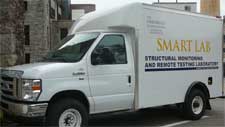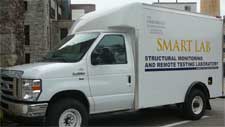 KINGSTON, R.I. – December 1, 2009 – Civil engineering students at the University of Rhode Island will soon take to the roadways to apply what they have learned in the classroom in real-world analyses of bridges, buildings and other structures, thanks to the creation of a mobile testing laboratory.
KINGSTON, R.I. – December 1, 2009 – Civil engineering students at the University of Rhode Island will soon take to the roadways to apply what they have learned in the classroom in real-world analyses of bridges, buildings and other structures, thanks to the creation of a mobile testing laboratory.
Funded with a $95,500 Champlin Foundations grant, the Structural Monitoring and Remote Testing (SMART) Laboratory includes the high-tech instrumentation and processing power necessary to measure and analyze structures in natural conditions, all contained in a van for easy access to sites around Rhode Island.
“The lab will enable students to work together in small groups designing experiments on challenging problems related to structural health monitoring, and then gain experience obtaining real-world measurements that can be applied in their future careers,” explained Mayrai Gindy, associate professor of civil engineering who developed the mobile lab.
According to Gindy, one of the most important challenges facing structural engineers today is the development and implementation of effective techniques for detecting, diagnosing and treating structural damage. The SMART lab will help students gain a clearer understanding of the behavior of structures under various conditions.
Among the equipment in the lab is a laser Doppler vibrometer, which measures the speed and displacement of a vibrating structure; various strain gauges that assess the stress, strain and loading on a structure; and an impulse hammer that measures how much force is applied in tests under controlled conditions. Also available are accelerometers, linear variable differential transducers, and a portable weigh-in-motion system.
“Some of the equipment is wireless, so students can be sitting here in a computer lab on campus and continually monitor the stress levels on a bridge almost anywhere,” Gindy said.
The Rhode Island Department of Transportation, which supported the grant application, also benefits from the new lab. When students prepare to conduct bridge tests, they coordinate with DOT engineers who identify particular bridges they would like tested, and the results of the tests are shared with the state agency, which does not own some of the equipment available in the SMART lab.
In addition, Gindy envisions using the lab for outreach activities at local high schools. She said that the equipment can be used to test the structural integrity of school flagpoles, windshields and other structures that will provide valuable mathematics, science and technology lessons to students.
The mobile lab will be in use beginning next semester, and will become a regular part of the junior-level structural engineering lab course next fall.

